Sitting at base camp, you go over your gear one more time. You know it’s all there, but you want to make certain. Each day as you rise you look towards the icefall, and you know that just beyond lies Camp 1 where you can catch your first glimpse of the summit far above, icy and windswept, looking just as it always has in your dreams.
You and your team have been at base camp for some time now, planning your course, and acclimatizing to the altitude. As you look around at their faces, you wonder whether they feel the same mix of fear and exhilaration that you do. You do your best to focus on the exhilaration and ignore the sense of foreboding, but this isn’t your first climb and you know there are dangers to face. Will you and your team have the strength and skill to accomplish what few others have done before you?
Soon you will know. You pack the last of your gear, take a deep breath, and set out with the others across the icefall to Camp 1. And so it begins…
Furious Ascent is a cooperative game for 2 to 4 players. The object of the game is for all players to progress as a team through four ascents to reach the mountain summit. If all players are healthy enough to reach the summit, the game is won. If any player becomes too injured to continue on during the game, it will result in an immediate loss.
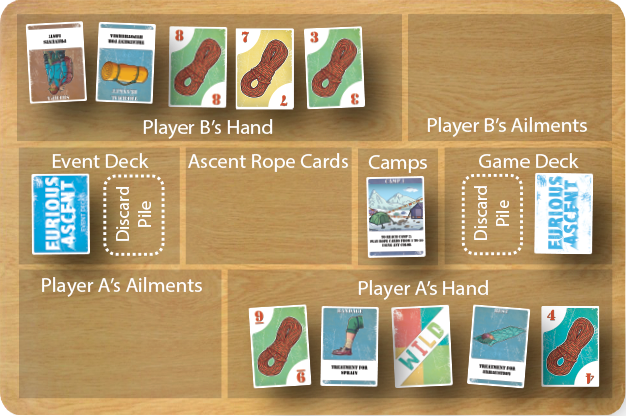
The cards used in Furious Ascent are divided into three types: Ascent, Game Deck, and Event Deck. Ascent cards define the objective for reaching the next camp or summit. Game Deck cards are used to form each team member’s hand, from which each then plays during his or her turn. Event Deck cards will present obstacles you must overcome to achieve your goal. The cards that make up these types are described in more detail below.
The game consists of four Ascents. You begin each game at Camp 1. Place the Camp 1 card in the center of the play area and follow the instructions on the card to ascend to the next camp. To ascend, players use rope and/or wild cards that meet the specified requirements. Once you complete the ascent, you have reached the next camp. Each ascent is played in sequence from Camp 1 to the Summit.
For example, when you complete the requirements on the Camp 1 card to ascend to Camp 2, you’ll gather up the cards you played to reach Camp 2 and place them on top of the Camp 1 card and place the Camp 2 card on top of the pile. Then, you’ll follow the instructions on the Camp 2 card for the ascent to Camp 3.

To ascend to Camp 2, your team must play rope or wild cards in order from 1 to 10. The color of the cards played does not matter.
To ascend to Camp 3, your team must play rope or wild cards in order from 1 to 8. You may only play rope cards of three colors, though it does not matter which three colors you use.
To ascend to Camp 4, your team must play rope or wild cards in order from 1 to 6. This time, you may only play rope cards of two colors, though, again, it does not matter which two colors you use.
To reach the summit, your team must play rope or wild cards in order from 1 to 4 using a single color.
When you reach the Summit, you have won the game.
|
Climbing is not without its dangers. The Event Deck contains cards that present obstacles you must overcome to achieve your objective. You must draw a random event card any time a player ends his or her turn without making progress in the ascent by playing a rope card. There are two types of Event cards: ailment cards and crisis cards.
These cards represent various ailments which may befall you while ascending the mountain. Each ailment has points ranging from 10 to 80 points, depending on how severely it affects the climber. If any player receives too many ailment points at a time, the player dies and the game is lost. This point limit (the Fatality Threshold) is based on the number of players on the team.
|
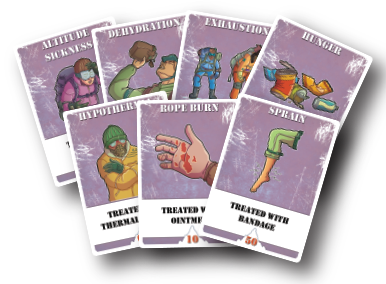 |
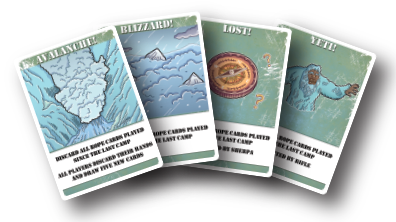
These cards are significant events that may greatly impact your team’s progress on its ascent. Some of these crises may be prevented and others may not. There are four crisis events that can occur:
Your worst nightmare has happened and it cannot be prevented. Discard all Rope and Wild cards played towards the current ascent and the team returns to the last camp reached. In addition, all players discard their hands and are dealt five new cards. Ailments are not removed in this process and remain in effect.
Not as severe as an Avalanche, but still unpreventable. Discard all Rope and Wild cards played towards the current ascent and the team returns to the last camp reached.
If any player has a Rifle card in hand, he or she may play it to negate the effects of the attack, even if it is not his or her turn. If no Rifle card is played, discard all Rope and Wild cards played towards the current ascent and return to the last camp reached.
If any player has a Sherpa card in hand, he or she may play it to negate the effects of getting lost, even if it not his or her turn. If no Sherpa card is played, discard all Rope and Wild cards played towards the current ascent and return to the last camp reached.
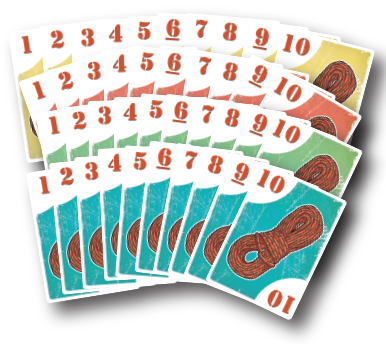 |
The Game Deck contains cards that you will draw into your hand and that you may play to make progress on your ascent, prevent crisis events, or treat ailments you or your teammates may experience.
Rope cards are needed to ascend from a camp to the next objective. Rope cards are numbered from one to ten in each of four colors. Some ascents restrict the number of colors that you can use to reach the next objective, so read the camp’s ascent requirements carefully before you play Rope cards.
|
You can substitute a Wild card for any numbered Rope card as a way to fill in where you are missing the next card in a sequence. Some Wild cards have a specific color and can only be substituted for a Rope card of that color. The deck also contains multicolor Wild cards that you can use as any color. Try to use the Wild cards sparingly; they may come in handy at the more difficult higher elevations.
|
 |
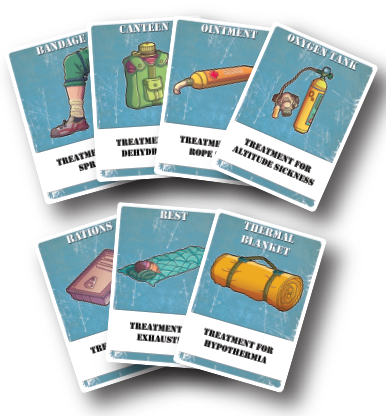 |
Use these cards to remove ailment cards from yourself and your teammates. You can treat only one ailment card per treatment card, but if you have more than one treatment card, you may treat more than one player (or the same player multiple times) during your turn. Use discretion in applying treatment; you may want to wait until a player really needs help.
|
These cards are used to prevent certain crisis events that can occur on your climb. They may be played by any player even if it is not their turn.
|
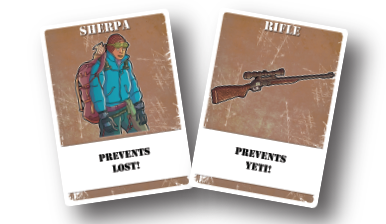 |
Download the Furious Ascent Instruction Booklet for Complete Game Play Details
|


